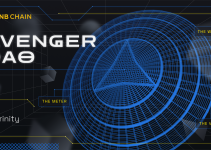Table of Contents

Discussions about Decentralized Physical Infrastructure (DePIN) are gaining momentum due to its potential to revolutionize the blockchain space with practical applications. Blockchain technology has already revolutionized several industries, notably finance through Decentralized Finance (DeFi), gaming via GameFi, and loyalty programs.
With the emergence of DePIN, we can now expand blockchain applications into new, previously untapped areas of physical infrastructure. DePIN utilizes tokens to deploy physical infrastructure, fostering a network effect that unlocks new design spaces for real-world-based decentralized applications (dApps).
This article explores DePINs as an emerging crypto trend that is leveraging blockchain technology for constructing and operating real-world physical infrastructure and hardware networks in a permissionless, trustless, and programmatic manner.
Plus, read ahead about our #DePIN Challenge and win BNB Chain swag. Ten winners will be selected to share a $500 Prize Pool.
What is DePIN?
Positioned as the potential next evolution of the Internet of Things (IoT) within the Web3 ecosystem, DePINs represent a decentralized IoT where users, device owners, and businesses collectively own and monetize infrastructure. Globally empowering individuals, these networks enable collaborative efforts in building, maintaining, and operating community-owned physical infrastructure without relying on a single centralized entity.
Furthermore, DePINs incentivize network development by engaging supply-side participants through crypto-economic protocols. The ultimate goal is to deliver more cost-effective and innovative services to end-users compared to traditional models, marking a significant leap forward in the practical applications of blockchain technology.
DePIN encompasses a diverse range of sectors, including decentralized storage networks like Greenfield, Arweave and Filecoin, WiFi solutions like Helium, and community-driven applications like Hivemapper. A recent Messari’s report classifies DePIN into six main categories: compute, wireless, energy, AI, services, and sensors. Real-world assets (RWAs) and blockchain infra networks, such as oracles and remote procedure call (RPC) nodes, are also considered DePIN-adjacent sectors.
Benefits of DePIN
The conceptual scope of DePIN is defined by shared characteristics:
- Permissionless entry
- Distributed infrastructure costs, and
- Economies of scale
The DePIN flywheel, driven by native tokens, involves users contributing resources for token rewards, expanding network capacity and attracting more users. Projects like Filecoin and Helium have extended the DePIN flywheel beyond hardware to data infrastructure and blockchain-based consumer data projects. Tokens serve as a unified interface, orchestrating a new data-based economy.
This extended perspective includes not only consumer-facing “sensor network projects” but also potential enterprise applications in supply chain or logistics management, with less focus on token financialization. Conceptually, DePIN as a trend involves the convergence of a decentralized hardware layer with a community-owned new data economy.
DePIN, distinguished by heightened efficiency, and resilience compared to centralized infrastructures, emerges as the leading solution for scaling global infrastructure. The economic potential is immense, with the DePIN Flywheel projected to contribute over +$10 trillion to global GDP in the next decade and an astonishing +$100 trillion in the following one.
DePIN is doing more than just changing the economy. It’s actually encouraging everyday people to get involved in making public infrastructure better. In a time where a lot of us are doubtful about big institutions and frustrated with slow bureaucracies, DePIN is stepping in as a game-changer. It’s shifting wealth and power back to regular folks and communities. What it’s offering is a future where we, as individuals, have a big say in the development of the infrastructure we use every day.
Greenfield As DePIN
Rooted in the “data-as-an-asset” principle, BNB Greenfield prioritizes user control over personal information and provides opportunities to capitalize on its value. The platform’s distinctive features make it an appealing choice for AI applications, particularly in terms of data access, ownership, and monetization.
Its decentralized data storage mechanism breaks away from centralized data silos, significantly enhancing data security and privacy. This distributed approach is especially critical for AI applications handling sensitive data, as it ensures that such information is not concentrated in a single point of vulnerability.
Greenfield helps to ensure secure and resilient data storage. Unlike centralized storage services that present a single point of failure, DePIN like Greenfield, strategically disperses data across numerous nodes or storage points, providing a robust alternative to conventional storage services.
This utilization of decentralized data storage networks eliminates the risk of data loss associated with vulnerabilities in centralized siloed data centers. By dispersing data across a global network of nodes, decentralized storage networks employed by BNB Greenfield significantly enhance data resilience and security.
DePIN Projects building on BNB Chain
In the diverse landscape of decentralized physical infrastructure (DePIN) projects within the BNB Chain ecosystem, several innovative initiatives are reshaping the way we perceive and interact with digital and physical environments.
AIOZ
AIOZ Network diligently develops infrastructure solutions for Web3 storage, decentralized AI computation, live streaming, and video on demand (VOD). With over 36,000 global nodes run by individuals, AIOZ Network aims to be a leading provider of decentralized infrastructure for Web3 dApps.
AIOZ Nodes reward users with AIOZ tokens for contributing spare computing power. The upcoming release, AIOZ Web3 Storage (W3S), is a versatile object storage infrastructure compatible with Web3 dApps, providing reliable, distributed, and cost-effective cloud object storage. W3S will integrate with major Web2 storage providers like IBM Cloud Storage and Oracle, enhancing data management and usability.
The project is working to launch user dApps on their W3S infrastructure soon, offering affordable decentralized storage options for individuals and aligning with AIOZ Network’s commitment to seamless dApp hosting.
Deeper Network
Deeper Network specializes in hardware and software solutions for network security, privacy protection, and blockchain mining. Through a peer-to-peer blockchain architecture, Deeper Network offers decentralized internet-based computing services, including content delivery and domain name resolution, facilitated by various dApps within its ecosystem.
The mining protocol of Deeper Network employs a proof-of-reliability consensus mechanism, ensuring that contributors receive native tokens proportionate to their node’s speed and reliability. Nodes, encompassing devices contributing resources such as storage and bandwidth, often include personal computers that meet Deeper’s hardware and software requirements.
Aleph.im
Aleph.im is a decentralized cloud infrastructure provider specializing in solutions for dApps. Their services offer blockchain-agnostic, high-speed, cost-effective, and trustless cloud solutions, with a focus on empowering decentralized artificial intelligence (AI) through compute nodes for efficient computations and enhanced data privacy.
The project aims to overcome current decentralized application limitations, providing fast cross-technology and cross-chain solutions within a secure and reliable decentralized ecosystem. Aleph.im’s network enables developers to create dApps and devices, exemplified by the MyAleph beta, a privacy-focused personal storage application replacing centralized cloud systems and note-taking software. In essence, Aleph.im contributes to the advancement of decentralized technologies, offering scalable solutions for a variety of daily-use applications.
DATS Project
Pioneering the DePIN category with a focus on Web3 security, the DATS Project introduces an innovative desktop application that efficiently allocates system resources without the necessity for additional hardware investments. Instead of relying on centralized, expensive infrastructure, DATS utilizes a vast pool of computing power from numerous participants, eliminating the need for significant investments and ensuring ownership among contributors.
This is achieved through their Proof of Resource smart contract, specifically leveraging micro-scale system resources from participants. This approach addresses various challenges in Web3 security, enhancing the performance of their Security Audit services. For instance, the system can proactively identify security vulnerabilities through hacker-like methods, providing advanced threat detection. Additionally, it boosts resilience against complex and sophisticated cyber attacks.
#DePINChallenge: Five Winners Get BNB Chain Swag
Using the examples above, come up with a creative solution using DePIN on BNB Chain! Think about how this technology can enable positive change in the global community or in your local area. Design a compelling infographic, video, AI generated image, or write a detailed thread.
Ten winners will be selected to share a $500 Prize Pool. Winners will be contacted one week from this article’s publishing date on January 18th. Prizes will be distributed within two weeks of that fate.
Instructions:
- This blog will be shared on Twitter/X. QT our post with #DePinChallenge
- Include your creative entry to the challenge.
- Tag three friends
- Bonus points! Use a BNB Chain ecosystem project to create your entry and tag them in your QT. Examples: QnA3.AI, ChainGPT, NFPrompt or others.
Conclusion
The emergence and growth of DePIN mark a transformative development within the blockchain ecosystem. Positioned as a consumer-facing application layer akin to DeFi, gaming, and social platforms, DePIN exhibits the potential for widespread adoption, influencing the demand for underlying blockchain technologies. As the DePIN trend gains momentum, it not only shapes the technological infrastructure but also influences the trajectory of decentralized governance.
Overall, the DePIN phenomenon introduces a dynamic dimension to blockchain innovation, bridging the gap between the digital and physical realms and redefining the possibilities for decentralized governance in the years to come.To explore more DePIN projects, use DappBay as your navigator.


